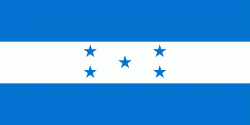La Jigua (La Jigua)
La Jigua is a municipality in the department of Copán in western Honduras, located approximately 30 km north of the departmental capital, Santa Rosa de Copán. Its name ultimately derives from Nahuatl Xihuacan, "place that has turquoise."
The municipality of La Jigua straddles the Chamelecón River valley at its point of confluence with the Tepemechín River. It borders the municipalities of Florida to the west and north, Nueva Arcadia to the east, and San Nicolás to the south. The municipality covers an area of 114 km2.
The terrain is a mixture of pastureland, farmland, and conifer and broadleaf forest.
La Jigua has a temperate climate with average daily temperatures that range from 18 to 30 C and an average annual relative humidity of 80%. The wettest months are September and October and the driest months are March and April.
The municipality of La Jigua straddles the Chamelecón River valley at its point of confluence with the Tepemechín River. It borders the municipalities of Florida to the west and north, Nueva Arcadia to the east, and San Nicolás to the south. The municipality covers an area of 114 km2.
The terrain is a mixture of pastureland, farmland, and conifer and broadleaf forest.
La Jigua has a temperate climate with average daily temperatures that range from 18 to 30 C and an average annual relative humidity of 80%. The wettest months are September and October and the driest months are March and April.
Map - La Jigua (La Jigua)
Map
Country - Honduras
 |
 |
| Flag of Honduras | |
Honduras was home to several important Mesoamerican cultures, most notably the Maya, before the Spanish colonization in the sixteenth century. The Spanish introduced Catholicism and the now predominant Spanish language, along with numerous customs that have blended with the indigenous culture. Honduras became independent in 1821 and has since been a republic, although it has consistently endured much social strife and political instability, and remains one of the poorest countries in the Western Hemisphere. In 1960, the northern part of what was the Mosquito Coast was transferred from Nicaragua to Honduras by the International Court of Justice.
Currency / Language
| ISO | Currency | Symbol | Significant figures |
|---|---|---|---|
| HNL | Honduran lempira | L | 2 |
| ISO | Language |
|---|---|
| ES | Spanish language |















